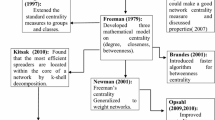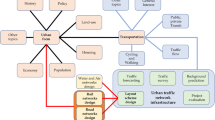Abstract
Social Networks (SNs) connect nodes from different geographical areas, keeping users updated about current affairs through message sharing. Natural calamities or deliberately imposed actions can cause Internet disconnections between geographical areas. This results in a SN partition which leads to communication loss between nodes inside the partitioned area. In this paper, we propose an extended Multi-Dimensional Routing (eMDR) algorithm using Greedy routing, which considers multiple attributes for routing. It improves the communication efficiency inside partitioned SNs. The performance of the proposed algorithm is validated by considering three dimensions/attributes, viz., social interest, geographical location and time-zones of social nodes on both real and synthetic SN datasets. The results of topological and routing probabilities for Chord and novel Social Interest Overlay networks, show considerable improvement in communication inside partitioned SNs.

















Similar content being viewed by others
References
Travers J, Milgram S (1969) An experimental study of the small world problem. Sociometry 32:425–443
Mei Li, Wang-Chien Lee, and Anand Sivasubramaniam. Semantic small world (2004) An overlay network for peer-to-peer search. In: Proceedings of the 12 th IEEE International Conference on Network Protocols, ICNP, pages 228–238. IEEE
Ding D, Conti M, Figueiredo R (2015) Impact of country-scale internet disconnection on structured and social p2p overlays. In: Proceedings of the 16 th IEEE International Symposium on a World of Wireless, Mobile and Multimedia Networks (WoWMoM), pages 1–9. IEEE
Gao L, Li M, Bonti A, Zhou W, Yu S (2013) Multi-dimensional routing protocol in human-associated delay-tolerant networks. IEEE Trans Mob Comput 12(11):2132–2144
Saberi S, Trunfio P, Talia D, Fesharaki MN, Badie K (2010) Using social network and semantic overlay network approaches to share knowledge in distributed data mining scenarios. In: Proceedings of the International Conference on High Performance Computing and Simulation (HPCS), pages 536–544. IEEE
Boccaletti S, Latora V, Moreno Y, Chavez M, Hwang DU (2006) Complex networks: structure and dynamics. Phys Rep 424(4):175–308
Crespo A, Garcia-Molina H (2004) Semantic overlay networks for p2p systems. In: AP2PC, volume 3601, pages 1–13. Springer
Sun W-j, Qiu H-m (2008) A social network analysis on blogospheres. In: Proceedings of the 15 th Annual International Conference on Management Science and Engineering, ICMSE, pages 1769–1773. IEEE
Mingxin Zhang. Social network analysis (2010) History, concepts, and research. In: Handbook of social network technologies and applications, pages 3–21. Springer
Babu KS, Jena SK, Hota J, networks BMA s (2013) A generalization approach. Computers & Electrical Engineering 39(7):1947–1961
Tsikerdekis M, Zeadally S (2014) Multiple account identity deception detection in social media using nonverbal behavior. IEEE Transactions on Information Forensics and Security 9(8):1311–1321
Wang S, Lin H, Hsu C-H, Yang F (2016) Collaboration reputation for trustworthy web service selection in social networks. J Comput Syst Sci 82(1):130–143
Open/R. Facebook routing platform, https://code.facebook.com/posts/1142111519143652/introducing-open-r-a-new-modular-routing-platform/ , 2016
Wang Y, Yun X, Li Y (2007) Analyzing the characteristics of gnutella overlays. In: Proceedings of the 4 th International Conference on Information Technology, ITNG'07, pages 1095–1100. IEEE
Rowstron A, Pastry PD (2001) Scalable, decentralized object location, and routing for large-scale peer-to-peer systems. In: IFIP/ACM International Conference on Distributed Systems Platforms and Open Distributed Processing, pages 329–350. Springer
Zhao BY, Huang L, Stribling J, Rhea SC, Joseph AD, Tapestry JDK (2004) A resilient global-scale overlay for service deployment. IEEE Journal on selected areas in communications 22(1):41–53
Kutzner K, Fuhrmann T (2005) Measuring large overlay networks: the overnet example. In: Kommunikation in Verteilten Systemen (KiVS), pages 193–204. Springer
Marti S, Ganesan P, Sprout HG-M (2004) P2p routing with social networks. In: EDBT Workshops, volume 3268, pages 425–435. Springer
Stoica I, Morris R, Liben-Nowell D, Karger DR, Frans Kaashoek M, Dabek F, Balakrishnan H (2003) Chord: a scalable peer-to-peer lookup protocol for internet applications. IEEE/ACM Transactions on Networking (TON) 11(1):17–32
Li M, Lee W-C, Sivasubramaniam A, Lee DL (2004) A small world overlay network for semantic based search in p2p systems. In: Proceedings of the 2 nd Workshop on Semantics in Peer-to-Peer and Grid Computing, New York, USA, pages 71–90
Lua EK, Crowcroft J, Pias M, Sharma R, Lim S (2005) A survey and comparison of peer-to-peer overlay network schemes. IEEE Communications Surveys & Tutorials 7(2):72–93
Xie J, Li Z, Chen G (2007) A semantic overlay network for unstructured peer-to-peer protocols. In: Proceedings of the International Conference on Parallel and Distributed Systems, volume 2, pages 1–8. IEEE
Zhang W, Zheng Q, Li H, Tian F (2012) An overlay multicast protocol for live streaming and delay-guaranteed interactive media. J Netw Comput Appl 35(1):20–28
Lee C, Choi J, Kim E (2014) A popularity-aware semantic overlay for efficient peer-to-peer search. Advances in Electrical and Computer Engineering 14(4):105–108
Pogkas I, Kriakov V, Chen Z, Delis A (2009) Adaptive neighborhood selection in peer-to-peer networks based on content similarity and reputation. Peer-to-peer networking and applications 2(1):37–59
Korzun D, Gurtov A (2014) Hierarchical architectures in structured peer-to-peer overlay networks. Peer-to-Peer Networking and Applications 7(4):359–395
Duan Z, Tian C, Zhou M, Wang X, Zhang N, Hongwei D, Wang L (2016) Two-layer hybrid peer-to-peer networks. Peer-to-Peer Networking and Applications:1–19
Liben-Nowell D, Novak J, Kumar R, Raghavan P, Tomkins A (2005) Geographic routing in social networks. Proc Natl Acad Sci U S A 102(33):11623–11628
Leskovec J, Horvitz E (2014) Geospatial structure of a planetary-scale social network. IEEE Transactions on Computational Social Systems 1(3):156–163
Jia S, Juste PS, Figueiredo RJ (2013) A multidimensional heuristic for social routing in peer-to-peer networks. In: Proceedings of the International Conference on Consumer Communications and Networking Conference (CCNC), pages 329–335. IEEE
Pan H, Crowcroft J, Yoneki E (2011) Bubble rap: social-based forwarding in delay-tolerant networks. IEEE Trans Mob Comput 10(11):1576–1589
Xia F, Li L, Jedari B, Pis SKD (2016) A multi-dimensional routing protocol for socially-aware networking. IEEE Trans Mob Comput 15(11):2825–2836
Zhu K, Li W, Xiaoming F (2014) Smart: a social-and mobile-aware routing strategy for disruption-tolerant networks. IEEE Trans Veh Technol 63(7):3423–3434
Li J, Ning Z, Jedari B, Xia F, Lee I, Tolba A (2016) Geo-social distance-based data dissemination for socially aware networking. IEEE Access 4:1444–1453
Dainotti A, Squarcella C, Aben E, Claffy KC, Chiesa M, Russo M, Pescape A (2011) Analysis of country-wide internet outages caused by censorship. In: Proceedings of the 2011 ACM SIGCOMM conference on Internet measurement conference, pages 1–18. ACM
Peter Mell, Richard Harang, and Assane Gueye. The resilience of the internet to colluding country induced connectivity disruptions. In Proceedings of the Workshop on Security of Emerging Networking Technologies, 2015
Onus M, Richa AW (2011) Minimum maximum-degree publish-subscribe overlay network design. IEEE/ACM Trans Networking 19(5):1331–1343
Gephi tool. The open graph viz platform, https://gephi.org /, 2016
Foursquare dataset. Using location-based services to get customers, https://archive.org/details/201309 foursquare dataset umn/, 2016
Levandoski JJ, Sarwat M, Eldawy A, Lars MFM (2012) A location-aware recommender system. In: Proceedings of the 28th International Conference on Data Engineering (ICDE), pages 450–461. IEEE
Sarwat M, Levandoski JJ, Eldawy A, Lars* MFM (2014) An efficient and scalable location-aware recommender system. IEEE Trans Knowl Data Eng 26(6):1384–1399
Yang D, Zhang D, Chen L, Bingqing Q (2015) Nation telescope: monitoring and visualizing large-scale collective behavior in lbsns. J Netw Comput Appl 55:170–180
Yang D, Zhang D, Bingqing Q (2016) Participatory cultural mapping based on collective behavior data in location-based social networks. ACM Transactions on Intelligent Systems and Technology (TIST) 7(3):30
Networkx. High-productivity software for complex networks, http://networkx.github.io , 2017
Sala A, Cao L, Wilson C, Zablit R, Zheng H, Zhao BY (2010) Measurement-calibrated graph models for social network experiments. In: Proceedings of the 19th international conference on World wide web, pages 861–870. ACM
Acknowledgements
This research work is funded by SERB, MHRD, under Grant (EEQ/- 2016/000413) for Secure and Efficient Communication Inside Partitioned Social Overlay Networks project, currently going on at National Institute of Technology Goa, Ponda, India.
Author information
Authors and Affiliations
Corresponding author
Additional information
Publisher’s Note
Springer Nature remains neutral with regard to jurisdictional claims in published maps and institutional affiliations.
Rights and permissions
About this article
Cite this article
Hussain, A., Keshavamurthy, B.N. A multi-dimensional routing based approach for efficient communication inside partitioned social networks. Peer-to-Peer Netw. Appl. 12, 830–849 (2019). https://doi.org/10.1007/s12083-018-0683-8
Received:
Accepted:
Published:
Issue Date:
DOI: https://doi.org/10.1007/s12083-018-0683-8




